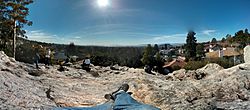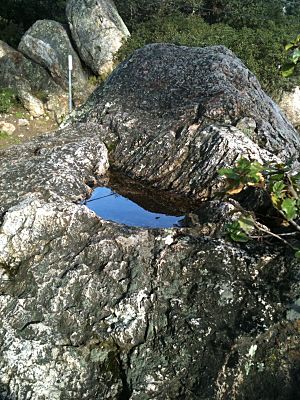Indian Rock Park facts for kids
Quick facts for kids Indian Rock Park |
|
|---|---|

The view from Indian Rock
|
|
| Lua error in Module:Location_map at line 420: attempt to index field 'wikibase' (a nil value). | |
| Type | Public |
| Location | 950 Indian Rock Avenue Berkeley, California, United States |
| Nearest city | Berkeley, California |
| Area | 1.18 acres (0.48 ha) |
| Created | 1917 |
| Status | Open year round |
Indian Rock Park is a public park in Berkeley, California. It covers about 1.18 acres (or 4,775 square meters). The park is located on the side of the Berkeley Hills, a beautiful area with great views.
The most important part of the park is a huge rock formation. This big rock is on the west side of Indian Rock Avenue. On the other side of the street, there are smaller rocks, grassy areas, and a place for picnics and barbecues. The main rock is made of a special type of volcanic rock called Northbrae rhyolite.
Contents
Exploring Indian Rock Park
Indian Rock Park is a fun place to visit. You can climb the main rock and enjoy amazing views. It's also a great spot for picnics and just relaxing outdoors.
What Can You See From the Top?
From the top of Indian Rock, you can see many famous landmarks. Look south to spot downtown Oakland and the University of California, Berkeley campus. To the west, you'll see central Berkeley, the San Francisco Bay, and the city of San Francisco. If you look northwest and north, you can see Marin County and Richmond, California. You can even see all three of the San Francisco Bay's largest bridges from here!
Climbing and Adventure
Indian Rock has been a popular place for rock climbing for a long time. Many people, especially those who enjoy bouldering (climbing on large rocks without ropes), come here to practice.
Famous climbers like Dick Leonard, known as the "father of modern rock climbing," and David Brower, a well-known environmentalist, learned their climbing skills at Indian Rock. They used these skills to help train soldiers during World War II.
Ancient History of the Rocks
Indian Rock is a large rock that formed from a volcano. There are many other similar volcanic rocks nearby. For example, just one block away is Mortar Rock Park, which also has its own group of granite rocks.
These rocks hold a special secret from the past. You can find many small holes carved into the solid rock. These are called acorn-grinding pits. They were made by the local Native American people, the Huichin band of the Ohlones. They used these pits to grind acorns into flour for food.
Getting Around the Park
There's a public path called Indian Rock Path that connects the park to other streets like Solano Avenue. To help people reach the top of the main Indian Rock, two sets of steps were carved into the rock. This happened many years ago during the 1930s.
History of the Park
The land for Indian Rock Park was given to the City of Berkeley in 1917. It was donated by Duncan McDuffie, a person who developed land and was also a president of the Sierra Club, a famous environmental group. He was also a mountaineer, meaning he loved climbing mountains.
Indian Rock Park has even been mentioned in the New York Times newspaper a few times, in 2010 and 2018.
- Indian Rock Park on LocalWiki


